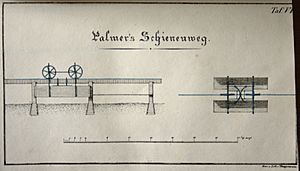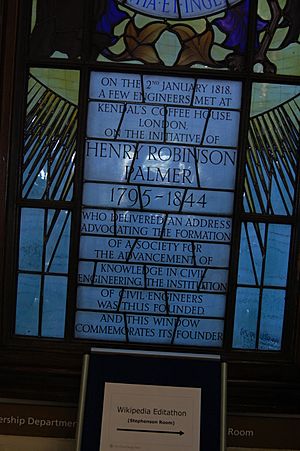Henry Robinson Palmer facts for kids
Henry Robinson Palmer (born 1795, died 1844) was a clever British engineer. He designed the world's second monorail and the very first railway that was built high up, like a bridge. He also invented corrugated metal roofing, which is still used a lot today for buildings!
Contents
Early Life and Learning
Henry Robinson Palmer grew up in Hackney, east London. When he was 16, he started learning to be a mechanical engineer with Bryan Donkin. He spent five years there, becoming very good at drawing plans.
After that, he worked for a famous engineer named Thomas Telford for about seven years. Henry became Telford's main helper. He traveled a lot, surveying land for canals and railways in places like Knaresborough and the Isles of Scilly.
In 1821, Henry got a special patent for his monorail system. A patent means he officially owned the idea. People thought his monorail idea was a bit strange at the time. But his work on how much effort it took to pull things (called "tractive effort") was very important.
In 1825, he visited early railways like the Stockton and Darlington Railway. He did tests to see how much power horses and trains needed to pull their loads. He also tested boats on canals. The results of his tests were even used in the British Parliament!
Working on His Own
By 1825, Henry wanted to start his own engineering business. He worked on plans for a railway called the Kentish Railway, which would go from Dover to Woolwich. However, the project didn't get enough money and stopped. He also surveyed for the Norfolk and Suffolk Railway, but again, it didn't go ahead.
Henry had more success with the Eastern Dock in London. He became the main engineer for this big project. He helped build the dock, warehouses, and special locks for ships. This work was mostly finished by 1833.
Henry Palmer did many surveys during his career. He planned many projects, but not all of them were built. Some important projects he did complete include improving Penzance harbour (1836-1839) and working on Ipswich Docks (1837-1842). He also worked on Port Talbot Harbour and Swansea Bridge in Wales in 1840. He retired from the Ipswich Docks project in 1842 due to poor health.
His Lasting Impact
Even though many of Henry Palmer's plans weren't fully built, he left a very important legacy. His biggest achievement was starting the Institution of Civil Engineers (ICE) in 1818.
Henry believed in learning and improving. He wanted young engineers to have a place to talk about their ideas and learn from each other. So, with a few other young engineers, he held the first meeting of the ICE on January 2, 1818. The goals he set for the Institution are still used today!
Later, Thomas Telford, Henry's old boss, became the President of the ICE, and Henry became the Vice-President. The Institution grew and became very successful with their leadership.
Henry Palmer passed away in 1844, just two years after he retired. All his drawings and papers were given to the ICE by his wife, but sadly, they were lost later.
Monorails: A New Idea
In 1821, Henry Palmer applied for a patent for his monorail. He imagined a single rail built high up on pillars, about ten feet apart. Carriages would hang from this rail on two wheels, one behind the other. A horse would walk on a path next to the rail, pulling the carriage.
Henry explained that his monorail would help carry materials and goods more cheaply. He also said that by building the rail high up, it would stay smooth and clear of things like snow or dirt on the ground.
There was an earlier monorail in Russia, but Henry didn't know about it. In 1823, another inventor named George Smart built a test version of Palmer's monorail.
The first real horse-powered elevated monorail started running in Cheshunt on June 25, 1825. It was meant to carry materials, but it was also used to carry people! In 1826, a German railway pioneer named Friedrich Harkort built a demonstration track of Palmer's system in Germany.
Henry Palmer's monorail ideas were very important. They helped inspire later monorails, like the famous Schwebebahn Wuppertal in Germany and the Lartigue Monorail.
Henry also wrote about an early idea for containerisation. This is where goods are put into special boxes (containers) that can be easily moved from one type of transport (like a train) to another (like a ship) without unpacking everything. He said his system would allow "receptacles" (containers) to be moved easily between different carriages or vessels.
See also
- Ivan Elmanov
Literature
- "Description of a Railway on a New Principle" - the study of Henry R. Palmer, London, 1823



